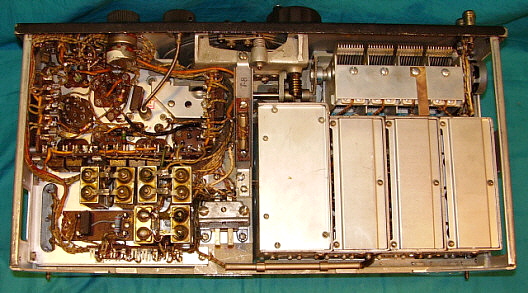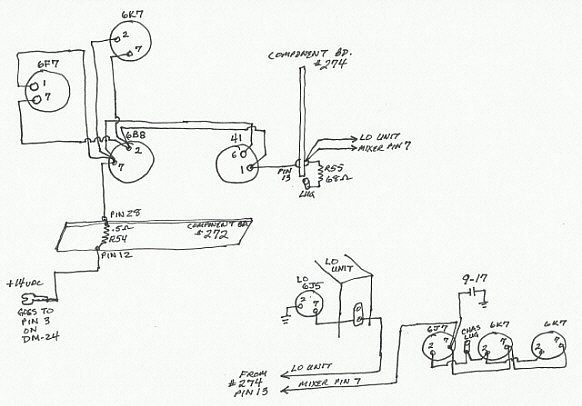1. Early versions (GCT version) use entirely different tubes. The RF amps and one IF amp are 6K7s, a 41 is used for the audio output, the LO is a 6J5 and the Mixer is a 6J7. These tubes functions were replaced with 6SK7, 6K6 and 6SA7 tubes in the later receivers.
2. A 991 Neon bulb is used a a voltage regulator for the LO on GCT receivers. Not used in SET receivers.
3. A 6F7 (large seven pin glass tube) is used as the 2IF and BFO functions. This tube will have a separate metal shield installed. This tube's functions were replaced by the 6SR7 and the 6SJ7 in the SET versions.
4. A 6B8 is used for the 3IF and Det/AVC functions. This metal octal with a grid cap tube was replaced by the 6SR7 and 6SJ7 tubes in the SET version.
5. The BFO and the Crystal Filter are fully shielded in square cans mounted on the top of the chassis.
6. A tracking RF gain control is coupled to the tuning condenser. Not used on SET versions.
7. The receiver construction uses component mounting that is "old-style RCA" using four component mounting boards with wires routed through a harness down to the tubes. This was simplified for the SET versions to mount most of the components on or near the tube sockets with only two component boards utilized. The use of so many component boards means much of the wiring is in harnesses that makes "wire tracing" very difficult.
8. Capacitor mounting under the dynamotor uses several individual metal body, oil filled, dual capacitors mounted together and connected to the circuit through wires in the harness. The SET version simplifies the component placement and use.
9. Placement of the audio output tube is significantly different with early versions locating the type 41 on the main chassis near the audio output transformer. The SET version locates the 6K6 on the small chassis on the right front of the receiver (with the two RF amplifier tubes - where the mixer tube is on early versions.) NOTE: Some GCT versions have a type 6K6 audio output tube.
There are several more changes such as layout, component designations and manufacturers used, wiring harness, etc. Since different tubes are utilized, the original series-parallel wiring is slightly different than the single-ended tubes version and the conversion to AC was slightly different. Dial lamp conversion is slightly different because of the +28vdc source changed in later receivers. You will have to make use of the correct wiring diagram for the early receivers. This is not a schematic but a pictorial of how the wires are connected to the various components, component boards and the harnesses.
|
|
BC-348-C Assessment
The victim,...I mean the receiver (shown above) to be retrofitted with the DM-28 dynamotor belongs to KØDWC who intends to run this BC-348-C in the ARC-8 configuration (with a dynamotor operated ART-13 transmitter.) The BC-348-C version was built by RCA in 1941. It was common to convert the "B" or "C" variations to cover 200kc to 500kc and then re-designate those receivers as "R." However, this particular "C" has not had the LF conversion making it somewhat rare.
Unfortunately, like much of the rare military gear that is found today, this early BC-348-C was at one time owned (and hacked up) by an avid reader of CQ magazine publications. CQ advocated the wholesale destruction of much of the military surplus gear under the guise of "modifications for ham radio operation" - in other words, mods that were poorly engineered and, in most cases, unnecessary. "Modification for modification's sake" was the CQ motto and many hams bought into the idea that they could "out engineer" the Professional Radio Engineering Teams that designed military radio gear to perform reliably under the worst conditions imaginable. Also, that they (the hams) could perform the mechanical and technical work better than the professional radio assemblers and technicians that were employed by the major radio manufacturing companies. Today we see these "hamster" results in the sloppy workmanship of hacked up modified gear we have to try to restore back to original operation and performance. A properly designed AC power supply conversion that was well-thought-out and well filtered was all that was necessary as a modification and this would not be a serious problem to convert back to dynamotor operation (or use "as-is.") However, this BC-348-C example we are restoring has had several other modifications besides the AC power supply and the quality of design and rework are strictly of the "hamster" caliber. Luckily for military radio enthusiasts, most BC-348 receivers encountered are usually not nearly so compromised by modifications as this example was.










